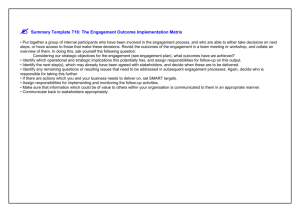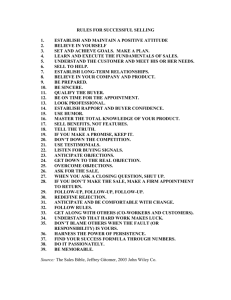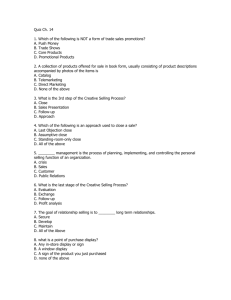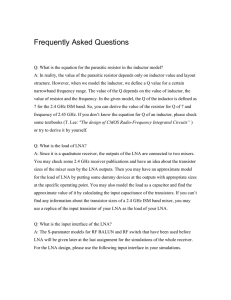Tool * Checklist for planning effective learning activities
advertisement
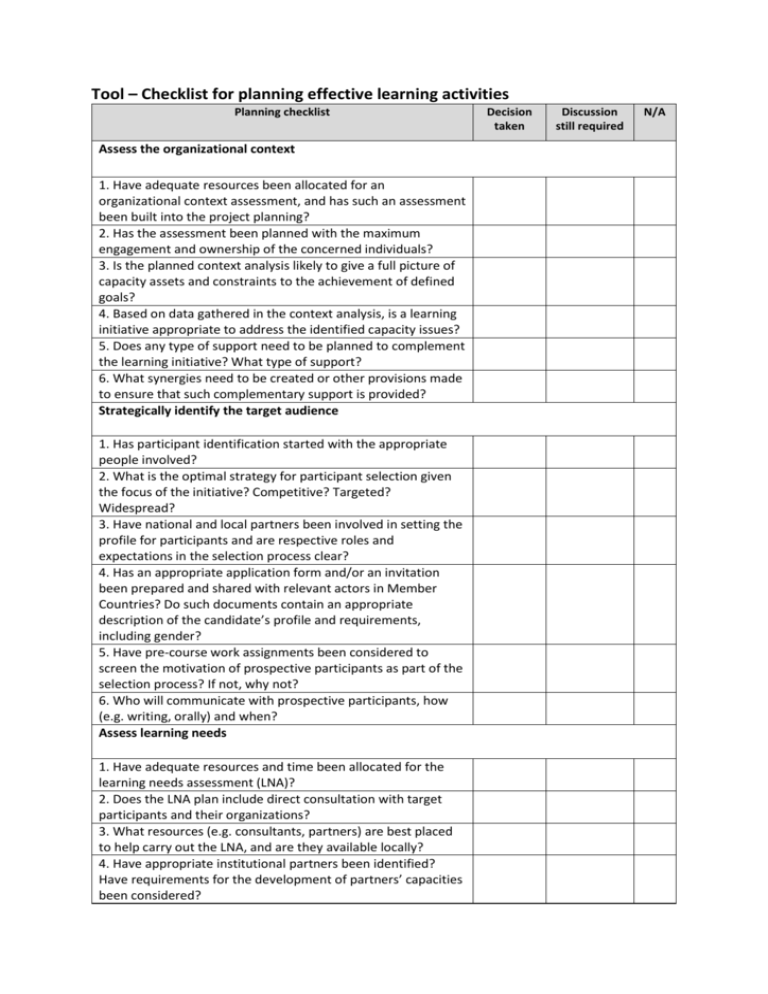
Tool – Checklist for planning effective learning activities Planning checklist Assess the organizational context 1. Have adequate resources been allocated for an organizational context assessment, and has such an assessment been built into the project planning? 2. Has the assessment been planned with the maximum engagement and ownership of the concerned individuals? 3. Is the planned context analysis likely to give a full picture of capacity assets and constraints to the achievement of defined goals? 4. Based on data gathered in the context analysis, is a learning initiative appropriate to address the identified capacity issues? 5. Does any type of support need to be planned to complement the learning initiative? What type of support? 6. What synergies need to be created or other provisions made to ensure that such complementary support is provided? Strategically identify the target audience 1. Has participant identification started with the appropriate people involved? 2. What is the optimal strategy for participant selection given the focus of the initiative? Competitive? Targeted? Widespread? 3. Have national and local partners been involved in setting the profile for participants and are respective roles and expectations in the selection process clear? 4. Has an appropriate application form and/or an invitation been prepared and shared with relevant actors in Member Countries? Do such documents contain an appropriate description of the candidate’s profile and requirements, including gender? 5. Have pre-course work assignments been considered to screen the motivation of prospective participants as part of the selection process? If not, why not? 6. Who will communicate with prospective participants, how (e.g. writing, orally) and when? Assess learning needs 1. Have adequate resources and time been allocated for the learning needs assessment (LNA)? 2. Does the LNA plan include direct consultation with target participants and their organizations? 3. What resources (e.g. consultants, partners) are best placed to help carry out the LNA, and are they available locally? 4. Have appropriate institutional partners been identified? Have requirements for the development of partners’ capacities been considered? Decision taken Discussion still required N/A 5. What information should be included in the concept note, with whom should it be shared (internally and externally) and for what purpose (e.g. fundraising, collaboration, synergies)? Design content and select delivery modes 1. Have S.M.A.R.T. learning objectives been defined? 2. Has the optimal delivery mode been identified and have the learners’ context and sustainability considerations been taken into account? 3. Has the support of a professional instructional designer been considered in designing the initiative? 4. Has a task analysis been carried out to help identify/prioritize content that is relevant to the needs of learners? 5. Has a design outline been developed and consensus created around it? 7. Has peer review and/or piloting of the initiative been arranged, and has integration of any lessons learned been planned? 8. Who will deliver the initiative, when and where? Have Letters of Agreement or contracts been stipulated and have all efforts been made to involve national/local resources? 9. Has a follow-up plan been developed? What provisions can and should be made for follow-up support? Have adequate resources been allocated for current or future projects? 10. What types of evaluation will be conducted to assess achievement of the objectives of the initiative? Have adequate resources been allocated? Deliver the learning solution 1. When identifying or appointing the facilitator(s), have appropriate skills for facilitating on-the-job and experiential learning been considered? 2. When identifying or appointing the facilitator(s), have appropriate skills for facilitating formal face-to-face learning initiatives been considered? 3. When identifying or appointing the tutors/ facilitator(s), have appropriate skills for facilitating online collaborative learning been considered? 4. Have gender and cultural aspects been considered in selecting the facilitating team and in organizing the initiative? 5. Have all opportunities been sought to use local resources for the initiative? Provide follow-up support 1. Is the follow-up plan being used as a reference for deciding the types of follow-up measures to put in place? Are these measures cost-effective? 2. Are follow-up measures included in the work plans for the learning initiative and have resources and time been committed? 3. If local partners take on the initiative and intend to upscale it in the future, what sort of support are they likely to need? 4. Do national partners need institutional support to uptake changes brought about by the learning initiative in their own context? 5. Have synergies been created with relevant actors within and outside FAO to ensure that the appropriate support is provided? Evaluate learning initiatives 1. Is the evaluation plan confirmed and have resources been budgeted, identified or committed for it? 2. Does the evaluation plan include both process and results evaluation? 3. Have adequate mechanisms been developed (e.g. questionnaires, surveys, knowledge test), based on the evaluation plan and available good practices? 4. Who will carry out the evaluation, and have specialized resources been sought where necessary? 5. Who has an interest in being informed about the result of the evaluation? Who has to be informed? 6. How are evaluation results integrated in future planning?


